+ Open data
Open data
- Basic information
Basic information
| Entry | Database: PDB / ID: 1ej5 | ||||||
|---|---|---|---|---|---|---|---|
| Title | SOLUTION STRUCTURE OF THE AUTOINHIBITED CONFORMATION OF WASP | ||||||
 Components Components | WISKOTT-ALDRICH SYNDROME PROTEIN | ||||||
 Keywords Keywords |  BLOOD CLOTTING / BLOOD CLOTTING /  alpha helix / beta-hairpin turn alpha helix / beta-hairpin turn | ||||||
| Function / homology |  Function and homology information Function and homology informationregulation of T cell antigen processing and presentation / regulation of actin polymerization or depolymerization /  Cdc42 protein signal transduction / GTPase regulator activity / actin filament-based movement / negative regulation of cell motility / vesicle membrane / actin polymerization or depolymerization / Cdc42 protein signal transduction / GTPase regulator activity / actin filament-based movement / negative regulation of cell motility / vesicle membrane / actin polymerization or depolymerization /  regulation of stress fiber assembly / regulation of stress fiber assembly /  regulation of lamellipodium assembly ...regulation of T cell antigen processing and presentation / regulation of actin polymerization or depolymerization / regulation of lamellipodium assembly ...regulation of T cell antigen processing and presentation / regulation of actin polymerization or depolymerization /  Cdc42 protein signal transduction / GTPase regulator activity / actin filament-based movement / negative regulation of cell motility / vesicle membrane / actin polymerization or depolymerization / Cdc42 protein signal transduction / GTPase regulator activity / actin filament-based movement / negative regulation of cell motility / vesicle membrane / actin polymerization or depolymerization /  regulation of stress fiber assembly / regulation of stress fiber assembly /  regulation of lamellipodium assembly / negative regulation of stress fiber assembly / endosomal transport / positive regulation of double-strand break repair via homologous recombination / RHOJ GTPase cycle / regulation of lamellipodium assembly / negative regulation of stress fiber assembly / endosomal transport / positive regulation of double-strand break repair via homologous recombination / RHOJ GTPase cycle /  phospholipase binding / CDC42 GTPase cycle / Generation of second messenger molecules / RHO GTPases Activate WASPs and WAVEs / epidermis development / phagocytic vesicle / RAC1 GTPase cycle / actin filament polymerization / phospholipase binding / CDC42 GTPase cycle / Generation of second messenger molecules / RHO GTPases Activate WASPs and WAVEs / epidermis development / phagocytic vesicle / RAC1 GTPase cycle / actin filament polymerization /  T cell activation / T cell activation /  actin filament / FCGR3A-mediated phagocytosis / defense response / Regulation of actin dynamics for phagocytic cup formation / actin filament / FCGR3A-mediated phagocytosis / defense response / Regulation of actin dynamics for phagocytic cup formation /  small GTPase binding / small GTPase binding /  SH3 domain binding / cellular response to type II interferon / cell-cell junction / SH3 domain binding / cellular response to type II interferon / cell-cell junction /  blood coagulation / blood coagulation /  actin cytoskeleton / site of double-strand break / actin cytoskeleton / site of double-strand break /  actin binding / protein-containing complex assembly / actin binding / protein-containing complex assembly /  immune response / immune response /  protein kinase binding / positive regulation of transcription by RNA polymerase II / extracellular exosome / identical protein binding / protein kinase binding / positive regulation of transcription by RNA polymerase II / extracellular exosome / identical protein binding /  nucleus / nucleus /  plasma membrane / plasma membrane /  cytosol cytosolSimilarity search - Function | ||||||
| Biological species |   Homo sapiens (human) Homo sapiens (human) | ||||||
| Method |  SOLUTION NMR / SOLUTION NMR /  simulated annealing, torsion angle dynamics simulated annealing, torsion angle dynamics | ||||||
 Authors Authors | Kim, A.S. / Kakalis, L.T. / Abdul-Manan, N. / Liu, G.A. / Rosen, M.K. | ||||||
 Citation Citation |  Journal: Nature / Year: 2000 Journal: Nature / Year: 2000Title: Autoinhibition and activation mechanisms of the Wiskott-Aldrich syndrome protein. Authors: Kim, A.S. / Kakalis, L.T. / Abdul-Manan, N. / Liu, G.A. / Rosen, M.K. | ||||||
| History |
|
- Structure visualization
Structure visualization
| Structure viewer | Molecule:  Molmil Molmil Jmol/JSmol Jmol/JSmol |
|---|
- Downloads & links
Downloads & links
- Download
Download
| PDBx/mmCIF format |  1ej5.cif.gz 1ej5.cif.gz | 608.1 KB | Display |  PDBx/mmCIF format PDBx/mmCIF format |
|---|---|---|---|---|
| PDB format |  pdb1ej5.ent.gz pdb1ej5.ent.gz | 529 KB | Display |  PDB format PDB format |
| PDBx/mmJSON format |  1ej5.json.gz 1ej5.json.gz | Tree view |  PDBx/mmJSON format PDBx/mmJSON format | |
| Others |  Other downloads Other downloads |
-Validation report
| Arichive directory |  https://data.pdbj.org/pub/pdb/validation_reports/ej/1ej5 https://data.pdbj.org/pub/pdb/validation_reports/ej/1ej5 ftp://data.pdbj.org/pub/pdb/validation_reports/ej/1ej5 ftp://data.pdbj.org/pub/pdb/validation_reports/ej/1ej5 | HTTPS FTP |
|---|
-Related structure data
| Related structure data | |
|---|---|
| Similar structure data |
- Links
Links
- Assembly
Assembly
| Deposited unit | 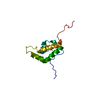
| |||||||||
|---|---|---|---|---|---|---|---|---|---|---|
| 1 |
| |||||||||
| NMR ensembles |
|
- Components
Components
| #1: Protein | Mass: 11603.597 Da / Num. of mol.: 1 Source method: isolated from a genetically manipulated source Source: (gene. exp.)   Homo sapiens (human) / Plasmid: PET11A / Species (production host): Escherichia coli / Production host: Homo sapiens (human) / Plasmid: PET11A / Species (production host): Escherichia coli / Production host:   Escherichia coli BL21(DE3) (bacteria) / Strain (production host): BL21 (DE3) / References: UniProt: P42768 Escherichia coli BL21(DE3) (bacteria) / Strain (production host): BL21 (DE3) / References: UniProt: P42768 |
|---|
-Experimental details
-Experiment
| Experiment | Method:  SOLUTION NMR SOLUTION NMR | ||||||||||||||||||||||||||||
|---|---|---|---|---|---|---|---|---|---|---|---|---|---|---|---|---|---|---|---|---|---|---|---|---|---|---|---|---|---|
| NMR experiment |
| ||||||||||||||||||||||||||||
| NMR details | Text: The structure was determined using standard 3D and 4D heteronuclear techniques. |
- Sample preparation
Sample preparation
| Details |
| |||||||||||||||||||||||||
|---|---|---|---|---|---|---|---|---|---|---|---|---|---|---|---|---|---|---|---|---|---|---|---|---|---|---|
| Sample conditions |
| |||||||||||||||||||||||||
Crystal grow | *PLUS Method: other / Details: NMR |
-NMR measurement
| NMR spectrometer |
|
|---|
- Processing
Processing
| NMR software |
| ||||||||||||||||||||||||||||
|---|---|---|---|---|---|---|---|---|---|---|---|---|---|---|---|---|---|---|---|---|---|---|---|---|---|---|---|---|---|
| Refinement | Method:  simulated annealing, torsion angle dynamics / Software ordinal: 1 simulated annealing, torsion angle dynamics / Software ordinal: 1 Details: The structures are based on a total of 2713 restraints, 2494 are NOE-derived distance constraints, 182 dihedral angle restraints, 31 distance restraints from hydrogen bonds. | ||||||||||||||||||||||||||||
| NMR representative | Selection criteria: lowest energy | ||||||||||||||||||||||||||||
| NMR ensemble | Conformer selection criteria: structures with the least restraint violations Conformers calculated total number: 100 / Conformers submitted total number: 20 |
 Movie
Movie Controller
Controller



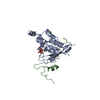
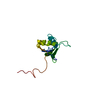
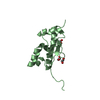
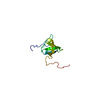
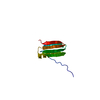
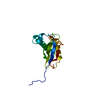
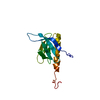
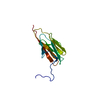
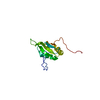
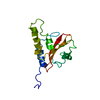

 PDBj
PDBj









